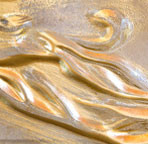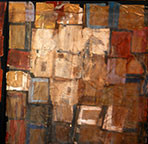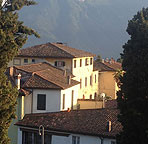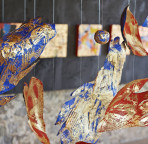Garcia-Rivera’s book, A Wounded Innocence: Sketches for a Theology of Art, presents a number of examples of specific works of art, both historic and contemporary, as he explores his premise that works of art articulate issues of doctrine. One example, which springs from the author’s involvement with the process of discovering the “authentic” theology of Latin America, is the body of stories and images which celebrate the life of Saint Martin de Porres. Because of his social status, and the political climate of the sixteenth century the Peruvian saint was not a likely candidate for beatification but the fervor of his follower’s testimony won the day. Fray Martin was a beatified a little more than a hundred years after his death. It was not until 1962 that he was finally canonized by Pope John XXIII.
Garcia-Rivera discusses the theology found in the popular image of the saint’s holy card, an image whose popularity in modern day Latin America, according to Garcia-Rivera, is second only to that of Our Lady of Gaudalupe. While a purely aesthetic assessment might dismiss the bulk of the images depicting this saint as so much “kitsch,” Garcia-Rivera explores the theology behind the image offering it as an example of popular art carrying profound religious insight. Garcia-Rivera first recounts the testimony from which the image springs: the story preserved in the official seventeenth century documents of the beatification process.
“One of the Dominican friars in St. Martin’s convent walked into a room near the kitchen to find a strange sight. At the feet of St. Martin were a dog and a cat eating peacefully from the same bowl of soup. The friar was about to call the rest of the monks in to witness this marvelous sight when a little mouse stuck his head out from a little hole in the wall. St. Martin without hesitation addressed the mouse as if he were an old friend. ‘Don’t be afraid little one. If you’re hungry come and eat with the others.’ The little mouse hesitated but then scampered to the bowl of soup from which the dog and the cat were eating. The friar who was watching all this take place tried to speak but no sound came out of his mouth. Here before his eyes, at the feet of the mulatto St. Martin, a dog, a cat, and a mouse were eating from the same bowl of soup, natural enemies eating peacefully side by side!”
Garcia-Rivera then offers the following: “The best interpretation of this story can be found in the holy card image of St. Martin. The key visual element is the white dove hovering above the bowl of soup and by the feet of St. Martin. The dove signifies a multitude of meanings. It signifies, for example, the spirit of peace. It interprets the dog, cat, and mouse all eating from the same bowl of soup as natural enemies now reconciled at the feet of the mulatto saint. The dove, however, also signifies the Holy Spirit who guided St. Martin’s feet in the path of sanctity. Additionally, the dove signifies the boundary between rationality and irrationality, a boundary that can be crossed in the form of a community. As such, the dove also tells us that this image is also an image of the endtimes.”
”Indeed, the image of St. Martin, in his habit as a Dominican friar, perhaps the order seen as the most “brainy” of all the orders, towering above the “irrational” creatures at his feet presents a vision of a marvelous community spoken about by Isaiah: ‘The wolf shall live with the lamb, the leopard shall lie down with the kid, the calf and the lion and the fatling together, and a little child shall lead them” (Isa 11:6).”
“That child is St. Martin who followed Christ in his mission of healing and forgiveness. St. Martin’s imitation of Christ becomes in this image an actual representation of the image of God. As such, it reveals God’s image as a deep religious insight. Although the human is the creature created in the image of God, the image of God involves a community, a community fully revealed in the endtimes. That is where the Holy Spirit is taking this world, transforming it tinder the guiding paths of her wings and the brilliant light of her wisdom.”
Google St. Martin of Torres and you can see many variations on this popular image, most of the artists are unknown. Garcia-Rivera comments, “Those who buy the holy card and are inspired by its image do not ask who is responsible for it. There is a profound sense in which the image is thought to emerge out of the very soul of the community’s devotion. Indeed, the artist responsible for the holy card image of St. Martin de Porres could be said to be the community itself.”





